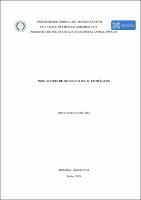| ???jsp.display-item.social.title??? |


|
Please use this identifier to cite or link to this item:
https://tede.ufam.edu.br/handle/tede/7242| ???metadata.dc.type???: | Dissertação |
| Title: | Indicadores de produção fecal em búfalos |
| ???metadata.dc.creator???: | Pantoja, Diego Souza  |
| ???metadata.dc.contributor.advisor1???: | Lima, Ronaldo Francisco de |
| ???metadata.dc.contributor.advisor2???: | Dias, Fabio Jacobs |
| First advisor-co: | Ferraz Junior, Marcos Vinícius de Castro |
| Second Advisor-co: | Cabral, Ícaro dos Santos |
| ???metadata.dc.contributor.referee1???: | Santos, Jomel Francisco dos |
| ???metadata.dc.contributor.referee2???: | Oliveira, Roseane Pinto Martins de |
| ???metadata.dc.description.resumo???: | Os indicadores são substâncias indigestíveis, geralmente de fácil determinação, utilizados como monitores químicos e físicos, em processos digestivos e metabólicos. Objetivou-se com a presente pesquisa avaliar indicadores de produção fecal em búfalos. Foram utilizados 18 búfalos (Bubalus bubalis) machos Murrah, com peso vivo médio de 150 kg. Os búfalos foram alimentados ad libitum individualmente em confinamento total do tipo Tie Stall. A mensuração da excreção fecal foi realizada através da coleta total de fezes e estimada por indicadores externos Lignina purificada e enriquecida (LIPE®), Óxido de Cromo (Cr2O3) e Óxido de Titânio (TiO2), e indicadores internos como: Matéria Seca indigestível (MSi), Fibra em Detergente Neutro indigestível (FDNi) e Fibra em Detergente Ácido indigestível (FDAi). A estimativa de excreção fecal e digestibilidade da Matéria Seca (MS), Matéria Orgânica (MO), Fibra em Detergente Neutro (FDN) e Extrato Etéreo (EE) estimados pelo Cr2O3 e o LIPE® não apresentaram ser diferentes das mesmas estimativas avaliadas pela coleta total de fezes com P>0.52. Já a excreção fecal estimada pelo TiO2 foi superestimada em relação a coleta total de fezes (5.34 versus 2.98 kg/dia de MS fecal, respectivamente). A excreção fecal estimada através do indicador externo TiO2, internos MSi, FDNi e FDAi, tiveram coeficiente de correlação positiva (r= 0.78 e P<0.01), (r= 0.72 e P<0.01), (r= 0.76 e P<0.01) e (r= 0.73 e P<0.01) respectivamente, em relação a excreção fecal observada através da coleta total de fezes. A digestibilidade da MS e da MO foram calculadas através da excreção fecal e estimadas pelos indicadores LIPE®, Cr2O3, TiO2, MSi, FDNi, e FDAi não apresentaram correlações significativas com as digestibilidades calculadas através da coleta total de fezes. A excreção fecal estimada pela FDNi teve correlação alta com a excreção fecal real calculada pela coleta total de fezes apresentando coeficiente de determinação significativo (r2= 0.58). Desta forma, os indicadores utilizados foram eficientes na determinação da produção fecal em búfalos confinados. |
| Abstract: | Indicators are indigestible substances, usually of easy determination, used as chemical and physical monitors, in digestive and metabolic processes. The objective of this research was to evaluate fecal production indicators in buffaloes. Eighteen male buffalo (Bubalus bubalis) Murrah were used, with a mean live weight of 150 kg. The buffaloes were fed ad libitum individually in total Tie Stall confinement. The measurement of fecal excretion was performed by total collection of feces and estimated by external indicators purified and enriched lignin (LIPE®), Chromium oxide (Cr2O3) and Titanium oxide (TiO2), and internal indicators such as: Indigestible Dry Matter (MSi), Indigestible Neutral Detergent Fiber (FDNi) and Indigestible Acid Detergent Fiber (FDAi). Estimates of fecal excretion and digestibility of dry matter (MS), organic matter (OM), neutral detergent fiber (FDN) and ethereal extract (EE) estimated by Cr2O3 and LIPE® were not different from the same estimates evaluated by the collection total stool with P>0.52. On the other hand, fecal excretion estimated by TiO2 was overestimated in relation to total fecal collection (5.34 versus 2.98 kg / day of faecal MS, respectively). The fecal excretion estimated using the external indicator TiO2, internal MSi, FDNi and FDAi, had a positive correlation coefficient (r= 0.78 and P<0.01), (r= 0.72 and P<0.01), (r= 0.76 and P<0.01) and (r= 0.73 and P<0.01), respectively, in relation to the fecal excretion observed through total fecal collection. The digestibility of DM and OM, calculated through fecal excretion estimated by LIPE®, Cr2O3, TiO2, MSi, FDNi, and FDAi indicators did not present significant correlations with digestibilities calculated through total fecal collection. The feacal excretion estimated by the FDNi had a high correlation with the actual fecal excretion calculated by the total collection of feces presenting a significant coefficient of determination (r2 = 0.58). In this way, the indicators used were efficient in determining the fecal production in confined buffaloes. |
| Keywords: | Búfalos - Alimentação e rações Búfalos - Fezes |
| ???metadata.dc.subject.cnpq???: | CIÊNCIAS AGRÁRIAS: ZOOTECNIA: NUTRIÇÃO E ALIMENTAÇÃO ANIMAL |
| ???metadata.dc.subject.user???: | Fibra em detergente neutro indigestível Matéria seca Murrah Óxido de cromo |
| Language: | por |
| ???metadata.dc.publisher.country???: | Brasil |
| Publisher: | Universidade Federal do Amazonas |
| ???metadata.dc.publisher.initials???: | UFAM |
| ???metadata.dc.publisher.department???: | Faculdade de Ciências Agrárias |
| ???metadata.dc.publisher.program???: | Programa de Pós-Graduação em Ciência Animal |
| Citation: | PANTOJA, Diego Souza. Indicadores de produção fecal em búfalos. 2019. 44 f. Dissertação (Mestrado em Ciência Animal) - Universidade Federal do Amazonas, Manaus, 2019. |
| ???metadata.dc.rights???: | Acesso Aberto |
| URI: | https://tede.ufam.edu.br/handle/tede/7242 |
| Issue Date: | 4-Jun-2019 |
| Appears in Collections: | Mestrado em Ciência Animal |
Files in This Item:
| File | Description | Size | Format | |
|---|---|---|---|---|
| Dissertação_DiegoPantoja_PPGCAN.pdf | 942.32 kB | Adobe PDF |  Download/Open Preview |
Items in DSpace are protected by copyright, with all rights reserved, unless otherwise indicated.




